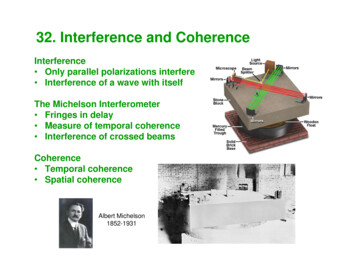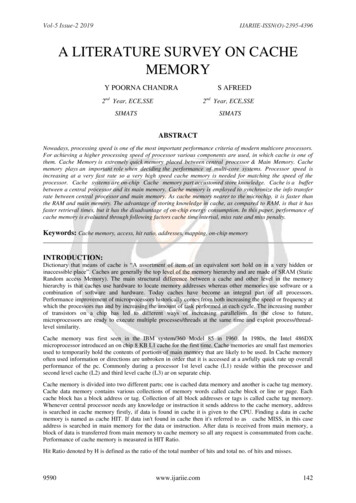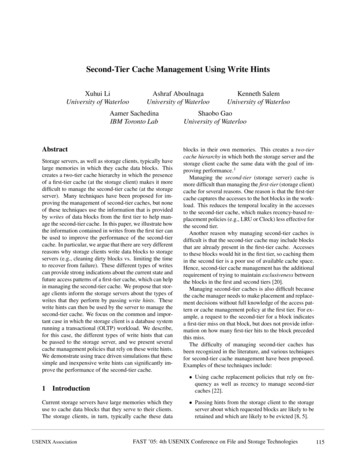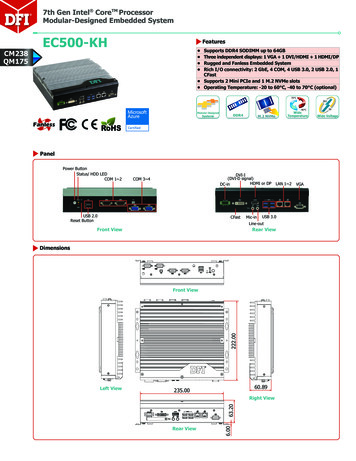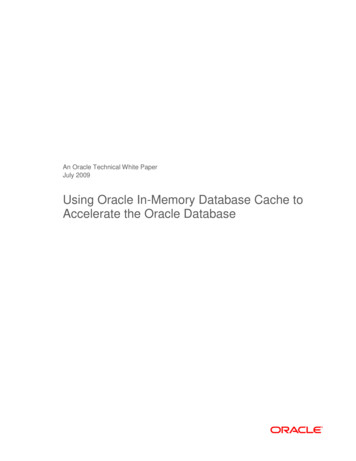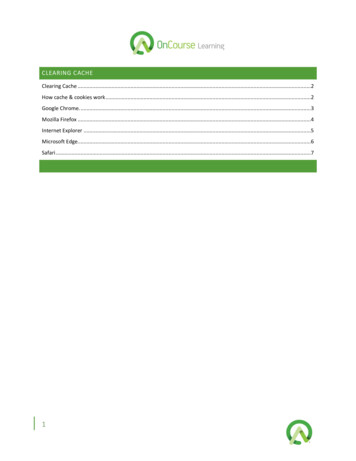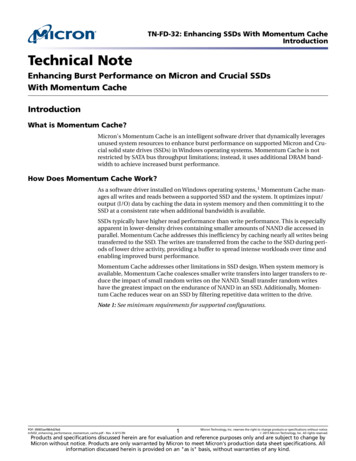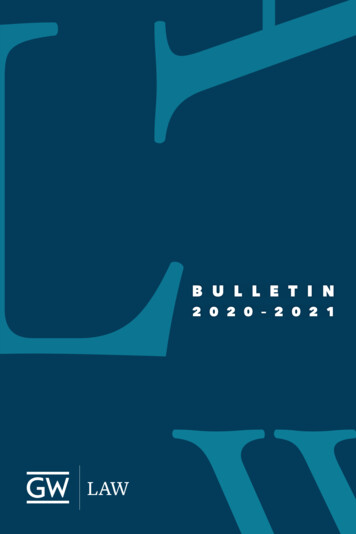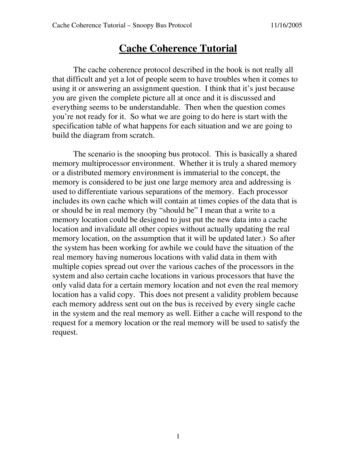
Transcription
Cache Coherence Tutorial – Snoopy Bus Protocol11/16/2005Cache Coherence TutorialThe cache coherence protocol described in the book is not really allthat difficult and yet a lot of people seem to have troubles when it comes tousing it or answering an assignment question. I think that it’s just becauseyou are given the complete picture all at once and it is discussed andeverything seems to be understandable. Then when the question comesyou’re not ready for it. So what we are going to do here is start with thespecification table of what happens for each situation and we are going tobuild the diagram from scratch.The scenario is the snooping bus protocol. This is basically a sharedmemory multiprocessor environment. Whether it is truly a shared memoryor a distributed memory environment is immaterial to the concept, thememory is considered to be just one large memory area and addressing isused to differentiate various separations of the memory. Each processorincludes its own cache which will contain at times copies of the data that isor should be in real memory (by “should be” I mean that a write to amemory location could be designed to just put the new data into a cachelocation and invalidate all other copies without actually updating the realmemory location, on the assumption that it will be updated later.) So afterthe system has been working for awhile we could have the situation of thereal memory having numerous locations with valid data in them withmultiple copies spread out over the various caches of the processors in thesystem and also certain cache locations in various processors that have theonly valid data for a certain memory location and not even the real memorylocation has a valid copy. This does not present a validity problem becauseeach memory address sent out on the bus is received by every single cachein the system and the real memory as well. Either a cache will respond to therequest for a memory location or the real memory will be used to satisfy therequest.1
Cache Coherence Tutorial – Snoopy Bus Protocol11/16/2005The cache will be set up in a standard memory hierarchy such as isdescribed in chapter 5 of the textbook. Whether it is directly mapped or setassociative is not important to this discussion so we will treat it as directmapped. Initially consider the size of the cache block (also called line) asbeing one memory address wide so you don’t have to deal with multiplewrite situations for a cache line in different processors (think about this one).The state protocol of the book, figure 6.11, can actually be represented in thecache by adding two bits to each cache line and these two bits will bemanipulated according to the rules set out in the table of figure 6.10. Notethat there are no extra bits attached to the real memory, only the caches.This diagram would apply mainly to a data cache, an instruction cachewould be similar except that there would be no write operations involved.RequestSourceState of addressedcache blockFunction and explanationRead hitprocessor Shared or exclusiveRead data in cache.Read missprocessor invalidPlace read miss on bus.Read missprocessor sharedAddress conflict miss: place read misson bus.Read missprocessor exclusiveAddress conflict miss: write back block,then place read miss on bus.Write hitprocessor exclusiveWrite data in cache.Write hitprocessor sharedPlace write miss on bus.Write missprocessor invalidPlace write miss on bus.Write missprocessor sharedAddress conflict miss: place write misson bus.Write missprocessor exclusiveAddress conflict miss: write back block,then place write miss on bus.Partial copy of figure 6.102
Cache Coherence Tutorial – Snoopy Bus Protocol11/16/2005We will create the diagram for the processor modifications to thecache states first and then deal with what happens at the other end, whenrequests come from the bus which actually means what other processorshave sent out from their cache control to our cache control. We start withjust the three states, without any transitions.InvalidShared(read only)Exclusive(read/write)Cache state transitionsbased on requests from CPUThis can be represented by two bits attached to the cache line. Theactual value of the bits, one or zero, is unimportant since the transitions willknow them and change them properly. We will now use the entries of thetable to build the transitions onto the diagram.First assume that we start with empty caches on all machines, the realmemory has a program in it that will be executed by the various processors.So the very first request for our processor, assuming our processor will startfirst and will cause the other processors to start up later, will find the cachefor the memory location to be invalid and hence will generate a Read missthat will cause a place read miss to go out on the bus. All the other cacheswill be in the invalid state so the real memory will respond with the data andreturn it to this cache putting it into the cache location and the state of thiscache line will now be shared. Our diagram now looks like this:3
Cache Coherence Tutorial – Snoopy Bus ProtocolInvalidCPU ReadSharedPlace read miss on busExclusive11/16/2005(read only)Cache state transitionsbased on requests from CPU(read/write)This will happen for a few locations as the program starts to executeand continues. At some point the same data location may be requestedagain. Now we left it in shared and no other processors have startedrunning yet. So now we will have the situation of a read hit. The requestfrom the processor will find the data in its own cache and it will use itdirectly, no access to the bus is involved.CPU read hitInvalidCPU ReadSharedPlace read miss on busExclusive(read/write)(read only)Cache state transitionsbased on requests from CPU4
Cache Coherence Tutorial – Snoopy Bus Protocol11/16/2005So now we’ve done two reads to the particular location, the first timeit had to get the data from real memory, the second time it found it in thecache. Now we will see what happens when we write to that location.Remember the cache line presently has the location in the state of shared.The write means that there will now be a new data value for that datalocation. This means that the state of this cache line will now change fromshared to exclusive and the data will be put into the cache line. It alsomeans that any other cache that also had a copy of the old data will nolonger be valid so the place write miss signal goes out on the bus to informthem of this fact.There’s a complication that has to be mentioned at this point, whenthe cache line is actually larger than one memory address which wouldnormally be realistic, then another cache in another processor may havemodified another part of that cache line. This means that the data we arewriting has to be merged with the data written from the other processor.This means that the data from the other cache has to be read into our cachebefore we update our part of the line. Putting the signal place write miss onbus will cause this to happen and then the data that we are writing will beput into its part of the cache line and our cache becomes the exclusive ownerof the memory location. The real memory may or may not have beenupdated during this process but the end result will be sure; all the othercaches will have invalidated any copies of the location and we will now havethe only good copy in our cache.CPU read hitInvalidCPU ReadSharedPlace read miss on busExclusive(read/write)(read only)Cache state transitionsbased on requests from CPU5
Cache Coherence Tutorial – Snoopy Bus Protocol11/16/2005If the state on our cache for the memory location had been invalid thisdoes not means that other caches were invalid also. It is possible that othercaches could have been in the exclusive or shared state for the memorylocation. This means that the same effect would have had to be initiated.The place write miss on bus signal would have had to be sent out, anyexclusive copies would have had to be transferred to our cache and allshared copies would have to have been invalidated and then our new copyof the cache line would be updated with the new value and the state wouldbecome exclusive.If the state on our cache for the memory location had been exclusive,then it would be easy. We would have a cache write hit on the location weare writing and the data would just need to be replaced with the new datafrom the processor. We are already in the exclusive state so we know thatthe cache line that we have has the most valid data of all the caches andmemory in the system.The same thing is true if we have a read hit when the cache state isexclusive for the particular memory location requested. We will stay in theexclusive state for this cache line and just use the data from the hit. Now thestate diagram looks like this:CPU read hitInvalidCPU ReadSharedPlace read miss on bus(read only)CPU writeExclusive(read/write)Cache state transitionsbased on requests from CPUCPU write hitCPU read hit6
Cache Coherence Tutorial – Snoopy Bus Protocol11/16/2005So far we have done two reads and one write to the same memorylocation and possibly we have done other reads and writes to other memorylocations also. We have also looked at other situations involving theexclusive state that were fairly simple. Now we have to consider theproblem of what happens when the line that is in the cache is not the one thatthe processor wants. This raises two possibilities, either we have to save theold contents before we use the cache location or else we just throw the olddata away.If we have the exclusive copy of the old data then it must be put backinto real memory before we can use the cache line for the new data. This isdone by doing a write-back block operation and then doing a place writemiss on bus operation or a place read miss on bus operation depending onwhether the data is being written or read. This will cause the old data to beput into real memory in both cases, read or write. Then the new data has tobe obtained and put into the cache line and finally the state of the cache linehas to be set according to whether the operation was a write (exclusive) or aread (shared). When the cache line desired is already occupied by anothermemory location data value then this is what is considered an addressconflict miss. The old data has to go (without losing it) and the new data hasto come in. The diagram now looks like this:CPU read hitInvalidCPU ReadSharedPlace read miss on bus(read only)CPU writeExclusiveCache state transitionsbased on requests from CPU(read/write)CPU write missCPU write hitCPU read hitWrite-back cache blockPlace write miss on bus7
Cache Coherence Tutorial – Snoopy Bus Protocol11/16/2005Remember that place write miss on bus and place read miss on buscause different things to happen. The read miss will just cause the contentsof real memory or the contents of some cache somewhere that has theexclusive state set for the particular address to be returned back to our cache.The place write miss on bus will not cause the old data to be written back,this is done by the write-back block operation beforehand. The place writemiss on bus will cause the same thing as mentioned previously for the writemiss operation on the shared or invalid states. It will go search for anexclusive copy in another cache and retrieve that or it will retrieve the blockfrom memory and put it into our cache and it will invalidate any other cachelines that have that memory location marked as shared.There is only one transition left that we have not mentioned. This iswhen the cache line is in the shared state but the address that we want needsto go into the same cache location because the memory addressing overlaps.In a direct mapped cache this always causes a replacement, in a setassociative cache there is an algorithm that determines which line in the setwill be replaced. The old data does not need to be retained because it wasalready shared in other caches (by virtue of this cache having it in theshared state) and real memory. So all that is required is that the new datavalue be obtained from real memory or another cache that has that memorylocation marked as exclusive (remember that the old cache line was sharedbut the new cache line we have to snoop to find out where it is. But the statestays shared because the new line will become shared everywhere by thenature of the fact that we did a read of the memory address. The finaldiagram is the same as figure 6.11 in the textbook.8
Cache Coherence Tutorial – Snoopy Bus Protocol11/16/2005The diagram on the left is the part that we have done. This isthe transitions that occurred in the cache line states from the requests of theprocessor. We took the viewpoint of our processor and cache and all theother ones were outside on the bus somewhere. Now we are going to takethe viewpoint as one of the caches out there on the bus. Now our cache,we’re still the same cache just on the other end of the requests, will receive arequest from the bus and do the transitions based on these requests.I suggest as an exercise that the student tries to build the right handdiagram from the table before continuing. Then use the rest of this tutorialto confirm your results.RequestSourceState of addressedcache blockFunction and explanationRead missprocessor invalidPlace read miss on bus.Read missprocessor sharedAddress conflict miss: place read misson bus.Write missprocessor invalidPlace write miss on bus.Write missprocessor sharedAddress conflict miss: place write misson bus.The rest of figure 6.10 for requests originating from the busInvalidShared(read only)Exclusive(read/write)Cache state transitionsbased on requests from the bus9
Cache Coherence Tutorial – Snoopy Bus Protocol11/16/2005Note that we are still dealing with the same two bits that are attachedto each cache line in our processor’s cache. Now we only deal with threetypes of requests occurring from the bus, a read miss, a write miss and awrite-back block. Be aware also that when these signals appear on the busthere is also the address that exists on the address lines of the bus. Thisaddress is compared to the address identified in the cache line to see if thiscache is actively concerned with the present transaction.The first situation is if the cache line concerned with the addresspresently on the bus is invalid. This is easy, because you will never get amatch and nothing will happen in our cache. The second situation, similar tothis, is if the cache line concerned with the address presently on the bus is inthe shared or exclusive state but the address does not match the address ofthe cache line presently resident. This will also not have anything happen.So the next situation is what will happen when our cache is in theshared state. If a read miss is requested and the address matches that whichis on the bus, then not much happens. The data will be obtained from realmemory for the other processor (unless some more elaborate data acquisitionscheme is devised where it can obtain the data from a nearby processors’cache, but we won’t consider that) so this cache will not have to provideanything. This cache will just remain in the shared state and that’s all.Same thing for a read miss on bus request but the address on the bus doesnot match the address in the cache line that it is associated with, the cacheline just stays as it is and the state remains as shared.For a write miss being on the bus with the address matching one ofour cache lines then a very simple transition occurs. The signal means thatanother processor is doing a write to the memory location so the data in ourcache line will no longer match the data for that address. The cache line willbe changed to the invalid state and nothing more needs to be done. So thediagram now looks like this:10
Cache Coherence Tutorial – Snoopy Bus Protocol11/16/2005CPU read missInvalidWrite miss for this blockShared(read only)Exclusive(read/write)Cache state transitionsbased on requests from the busWhen the cache line state is exclusive and the address on the busmatches the address of the cache line then a little bit more happens. Theexclusive state designation indicates that this cache line in this processor hasthe most up-to-date data in the cache line. This is only of concern if theaddress on the bus matches the cache line address because we need to putthe data onto the bus. If the address is different then even if the cache line iswhere the address would go, we leave the cache line alone, because theaddress on the bus is being requested for the purposes of another processorand our processor doesn’t need to get involved. But if the addresses domatch then the data has to be put out on the bus and the state of this cacheline has to be changed. A read miss indicates that another processor needs touse the data. This means to our cache; share it. So the data will be put outonto the bus and the real memory and the requesting processor will obtain acopy. Our cache will still have a valid copy but now it is shared so thetransition will be to the shared state. Note in the diagram of figure 6.11 itstates “Write-back block; abort memory access”, the abort memory accessrefers to the fact that the data in memory is not valid because the data in thiscache is the most up-to-date. What is aborted is the corresponding read ofthe memory location that now turns out to be useless. But the write-backblock operation does put the valid data back into the real memory location.11
Cache Coherence Tutorial – Snoopy Bus Protocol11/16/2005On a write miss where the address on the bus matches the address ofone of our cache lines then our cache has to go into action again. First itmust put the valid data from the cache line on to the bus so that the otherprocessor can get it and maybe also the real memory can make a copyalthough it is not really necessary since the other processor will have thedata marked as exclusive. Then the state will transition to invalid whichmarks this cache line as invalid. The reason for this is that the write misssignal being on the bus means that another processor is doing a write to thememory location within the cache line range of addresses. We have to sendall the data we have for the cache line over to the other processor so that itcan add its portion and keep the new data as its own exclusive copy. Nowthe diagram of figure 6.11 is complete for both sides.The two sides are joined together in figure 6.12 and it looks verycomplicated and easy to misinterpret. But having built the table into adiagram it should be an easy process to reconstruct it if necessary.12
Read miss processor exclusive Address conflict miss: write back block, then place read miss on bus. Write hit processor exclusive Write data in cache. Write hit processor shared Place write miss on bus. Write miss processor invalid Place write miss on bus. Write miss processor shared Address conflict miss: place write miss on bus.
